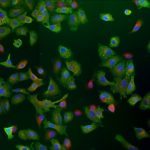Link to Pubmed [PMID] – 19019950
Link to DOI – 10.1128/JVI.00977-08
J Virol 2009 Feb; 83(3): 1320-31
Strong determinants of the host range of influenza A viruses have been identified on the polymerase complex formed by the PB1, PB2, and PA subunits and on the nucleoprotein (NP). In the present study, molecular mechanisms that may involve these four core proteins and contribute to the restriction of avian influenza virus multiplication in human cells have been investigated. The efficiencies with which the polymerase complexes of a human and an avian influenza virus isolate assemble and interact with the viral NP and cellular RNA polymerase II proteins were compared in mammalian and in avian infected cells. To this end, recombinant influenza viruses expressing either human or avian-derived core proteins with a PB2 protein fused to the One-Strep purification tag at the N or C terminus were generated. Copurification experiments performed on infected cell extracts indicate that the avian-derived polymerase is assembled and interacts physically with the cellular RNA polymerase II at least as efficiently as does the human-derived polymerase in human as well as in avian cells. Restricted growth of the avian isolate in human cells correlates with low levels of the core proteins in infected cell extracts and with poor association of the NP with the polymerase compared to what is observed for the human isolate. The NP-polymerase association is restored by a Glu-to-Lys substitution at residue 627 of PB2. Overall, our data point to viral and cellular factors regulating the NP-polymerase interaction as key determinants of influenza A virus host range. Recombinant viruses expressing a tagged polymerase should prove useful for further studies of the molecular interactions between viral polymerase and host factors during the infection cycle.


